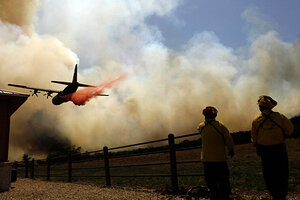Texas wildfires burn 'border to border;' cold front lifts hopes
Texas wildfires have burned hundreds of thousands of acres just in the past week, as flames ring entire lakes, jump firebreaks, and threaten towns and cities, including Dallas-Fort Worth.

Firefighters look on as an air tanker makes a pass over a wildfire near Possum Kingdom, Texas, on Tuesday, April 19.
LM Otero/AP
Thousands of firefighters, smoke jumpers, and bulldozer drivers struggled Wednesday to contain a historic Texas wildfire season, as more blazes cropped up and dozens of large wildland fires burned out of control throughout the state.
"One thing you've got to accept when you've got 45-mile-an-hour winds with humidity in the single digits and dry fuels, you're not going to stop that fire," says Marq Webb, a spokesman for the Texas Forest Service. "It's kind of like eating an elephant: You take one bite at a time."
In the past week, a swath of Texas nearly the size of Rhode island has burned as flames as high as 40 feet lap up the landscape, adding to the almost 2 million acres total that have ignited since the wildfire season began in December.
Fires have prompted evacuations in several towns, including along Possum Kingdom Lake near Fort Worth, where at one point the fire ringed nearly the entire shore of the 17,000-acre waterway. According to Gov. Rick Perry, the state has seen nearly 8,000 fires since December, with more than 250 homes destroyed or damaged.
Near Dallas, four separate fires merged Tuesday, forcing the evacuation of three towns west of the metro area. In many cases, residents are leaving their sprinkler systems on as they depart, hoping irrigation will protect their homes.
Historically dry weather, a large amount of dry grass and scrub (which cropped up after hurricane Alex soaked the state last August), and seasonal high winds have resulted in fires in 252 of Texas's 254 counties. The entire state is now painted red on fire warning maps, with fires with names such as East Sidwynicks, Cannon Fire Complex, Frying Pan Ranch, and Rockhouse dotting the response maps, says Mr. Webb.
"Never in my life have I seen anything of this magnitude – wildfires that are sweeping across 30,000-acre ranch after 30,000-acre ranch," says Revis Daggett, an inn owner in Fort Davis, Texas.
Texas, which has called on the federal government to send more help, is fighting the fires with bulldozers, pumper trucks, water-carrying Blackhawk helicopters, and modified C-130 refueling planes. More than 1,500 local, state, and national firefighters are on scene, and Texas beefed up its resources this week as weather conditions continued to confound firefighting efforts.
A cold front carrying a 30 percent chance of rain will sweep across the state on Wednesday, said National Weather Service meteorologist Dan Byrd, on hand at the Texas Forest Service headquarters in Merkel. The storm could help calm some of the flames, but the danger of lightning carries the possibility of sparking new fires.
Because few other parts of the country are currently facing fire risks, the depth of national resources is not an issue, says the US Forest Service. "We are committed to support Texas in every way we can," says Becky Rine, a program manager at the US Forest Service in Washington.
But the logistical complexity in a state this big, erratic fire behavior, and some residents knowingly or inadvertently starting new fires have impeded the firefighting effort.
"We're actually seeing Texas burn from border to border ... it's all over the state," April Saginor, Texas Forest Service spokeswoman, told CNN Radio.
